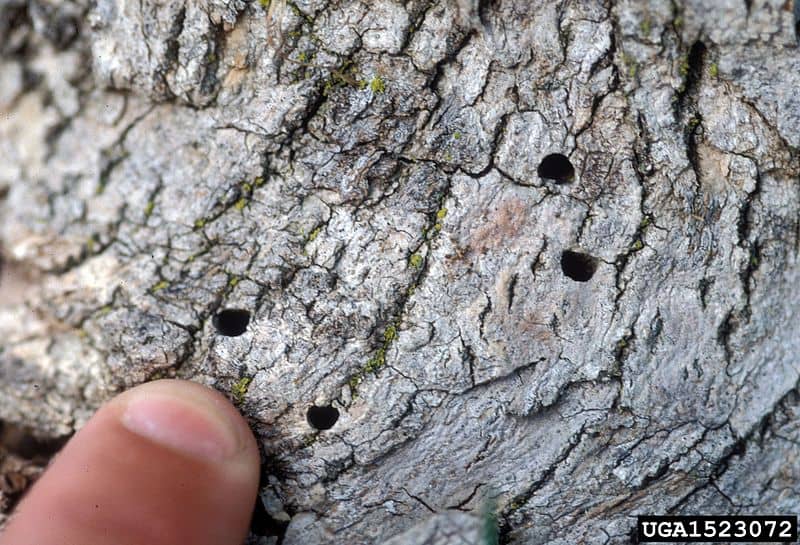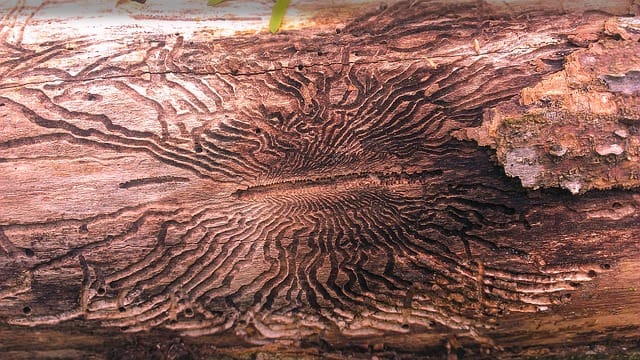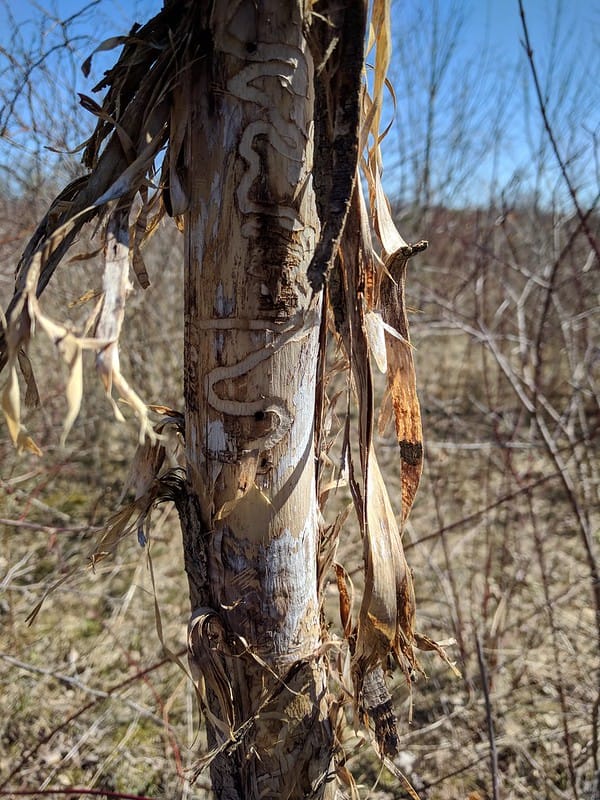What Are Borers?
Borers are wood-boring insects that are typically larvae of certain moths and beetles. These borers will feed and live under the bark of living plants and trees. The create tunnels that destroy the water and sap conducting tissues of the plant. Clearwing borers and flathead borers are the types that usually attack woody ornamentals. The best control for these pests is to maintain a healthy plant.
Symptoms and Identification of Borers
One resource for borer identification is this compilation of insect photos that have a search function to help identify them: https://www.forestryimages.org/search/action.cfm?q=Borer. A lot of the time you don’t directly see borers, so this isn’t all that helpful, but you will see the holes they leave upon exit through the bark. Once larvae are inside the tree (beneath the bark) they are no longer vulnerable to insecticides and are often undetected until serious damage has been done.
Symptoms of borers include the following:
Clearwing Borers
- Wilting of terminal shoots
- Branch and crown dieback
- Cankers, calluses, and cracked bark are manifestations of an infestation site
- Large branches that die or easily break in the wind
- Brown frass (sawdust-like) in the cracks of bark or mixed with oozing sap (Prunus species)
- Holes in the trunk from either woodpeckers or from the emergence of an adult borer larva
Flathead Borers
- D-shaped holes
- Thinning and dieback of the upper 1/3 of the canopy
- A lack of brown frass (which would indicate a clearwing borer)
For images of plants with borers scroll to the bottom for help in identifying if it is affecting your plant. If you have photos you’d like to add to the photos below you can send them to [email protected].
Life Cycle
While the timing varies by species, adult borers will enter a host through the bark, and leave eggs in crevices and underneath the bark. The larvae feed on the nutrients flowing through the tree and then bore a hole to exit upon maturation.
Management of Borers
Biological Control
Clearwing moth larvae are one of the few borers that you can successfully control with beneficial nematodes (Steinernema nematodes to be exact).
Cultural Control
The best way to manage and control borers is to keep a healthy tree. The easiest way to do this is to give your tree sufficient water. If your tree is mature, a soaking of the root zone maybe 5 times a year with 3 of them being in June, July, and August would be sufficient for most drought tolerant tree species. This article written by associates at The University of Arizona mentions that additional water should be provided in each month with total rainfall being under 2 inches.
Avoid mechanical injury to the tree and roots. Keep string trimmers away from trunk (easier if you keep grass from growing close to the tree trunk), machinery away from the root zone, protecting tree trunks from sunburn (a common winter phenomena in the high desert with species such as apple, maple, honey locust, birch, flowering cherry, fruit trees, and ash), and if a species is especially susceptible (Eldarica Pine, Arizona Cypress, Prunus spp. [cherry, apple, plum, crabapple, flowering peach/plum/apricot], Eucalyptus, Leyland Cypress) avoid pruning the tree while adult borers are flying which is usually late winter through late summer, but can vary depending on the particular borer.
Chemical Control
Chemical control of borers is uncommon unless a tree is of high value. This would require proper identification of the borer and then proper use and timing of the applicable insecticide.
Insecticides will not save heavily infested trees due to the extensive damage done and the lack of impact that they have on borers already inside the tree.
Toxicity
As with almost all chemicals there is an associated toxicity rating for the active ingredients of different pesticides, fungicides, herbicides, and rodenticides. Here are a few places you can learn more about their toxicity with a table of their rating and what the rating means (first is the preferred):
http://pods.dasnr.okstate.edu/docushare/dsweb/Get/Document-3591/EPP-7457web.pdf
https://extension.psu.edu/toxicity-of-pesticides
Below are some photos of borer damage to help you diagnose your plants:
Second photo: https://www.flickr.com/photos/gforsythe/27762691908



